Qantas Airways: Structure, Leadership, and Marketing Strategies
VerifiedAdded on 2021/06/16
|10
|2817
|34
Report
AI Summary
This report provides a comprehensive analysis of Qantas Airways, examining its organizational structure, leadership styles, and marketing strategies. The report begins with an introduction to Qantas, highlighting its position in the airline industry and its historical background. It then delves into the company's organizational structure, identifying it as a matrix type and discussing the roles of various departments and teams. The report also explores Qantas's leadership styles, noting the use of both authoritarian and participative approaches, and the importance of vision and employee input. Furthermore, the report examines the company's marketing strategies, including overseas marketing tactics, cost efficiencies, and brand segmentation. The analysis concludes with comments on the effectiveness of the organizational structure and strategies, emphasizing their role in achieving the company's goals and maintaining a strong market position. The report underscores the importance of aligning organizational structure, leadership, and strategies for overall business success.
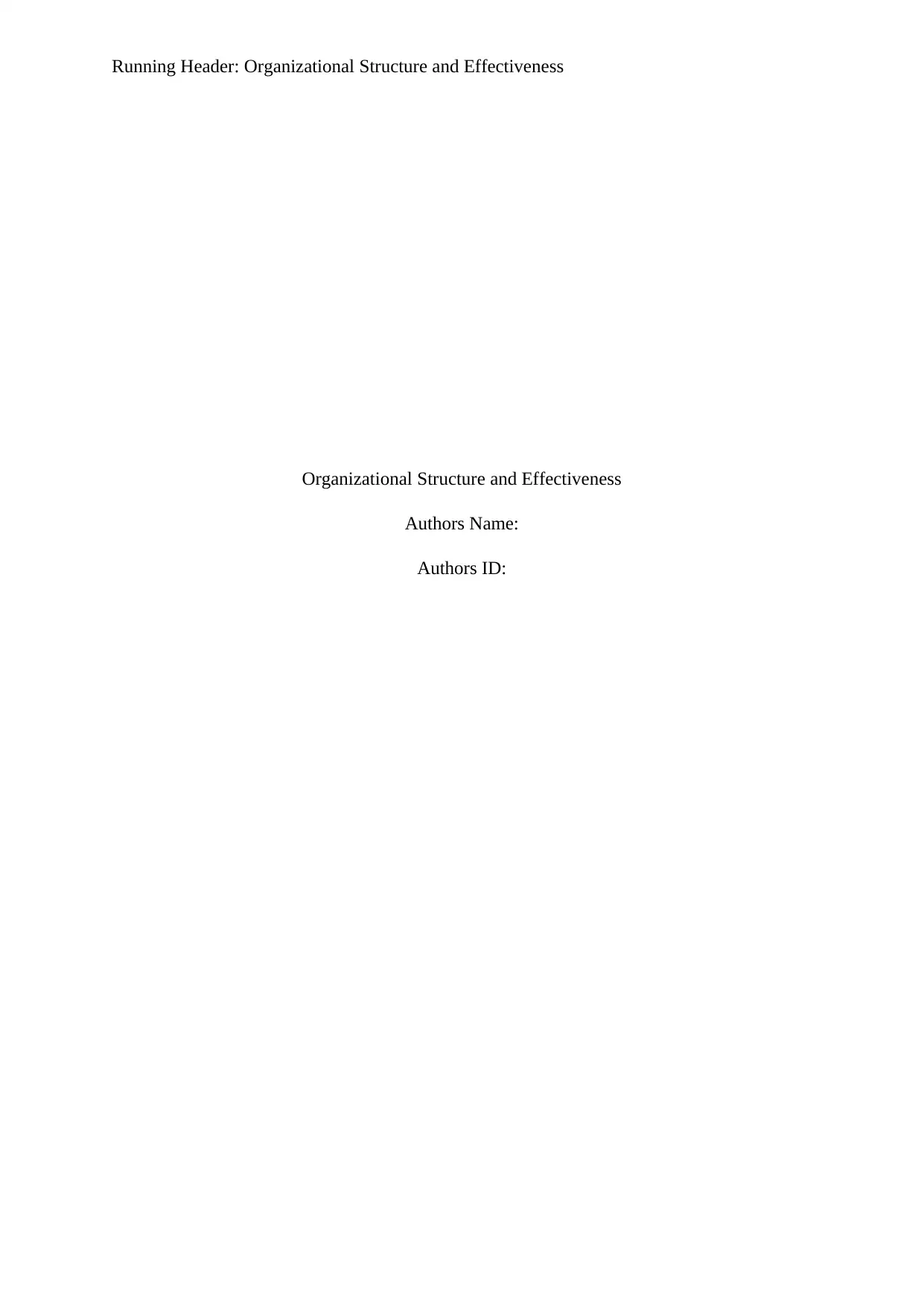
Running Header: Organizational Structure and Effectiveness
Organizational Structure and Effectiveness
Authors Name:
Authors ID:
Organizational Structure and Effectiveness
Authors Name:
Authors ID:
Paraphrase This Document
Need a fresh take? Get an instant paraphrase of this document with our AI Paraphraser
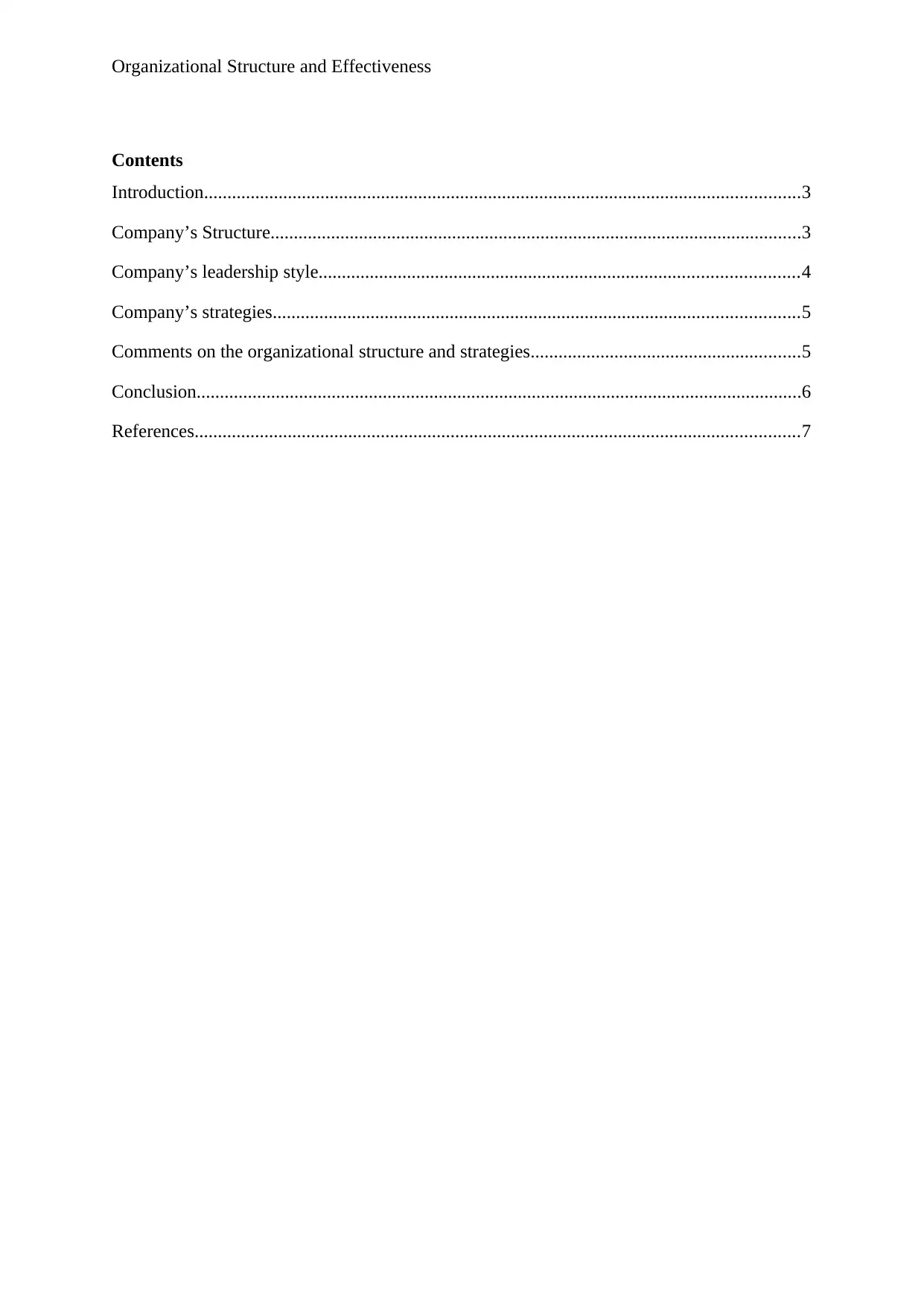
Organizational Structure and Effectiveness
Contents
Introduction................................................................................................................................3
Company’s Structure..................................................................................................................3
Company’s leadership style.......................................................................................................4
Company’s strategies.................................................................................................................5
Comments on the organizational structure and strategies..........................................................5
Conclusion..................................................................................................................................6
References..................................................................................................................................7
Contents
Introduction................................................................................................................................3
Company’s Structure..................................................................................................................3
Company’s leadership style.......................................................................................................4
Company’s strategies.................................................................................................................5
Comments on the organizational structure and strategies..........................................................5
Conclusion..................................................................................................................................6
References..................................................................................................................................7
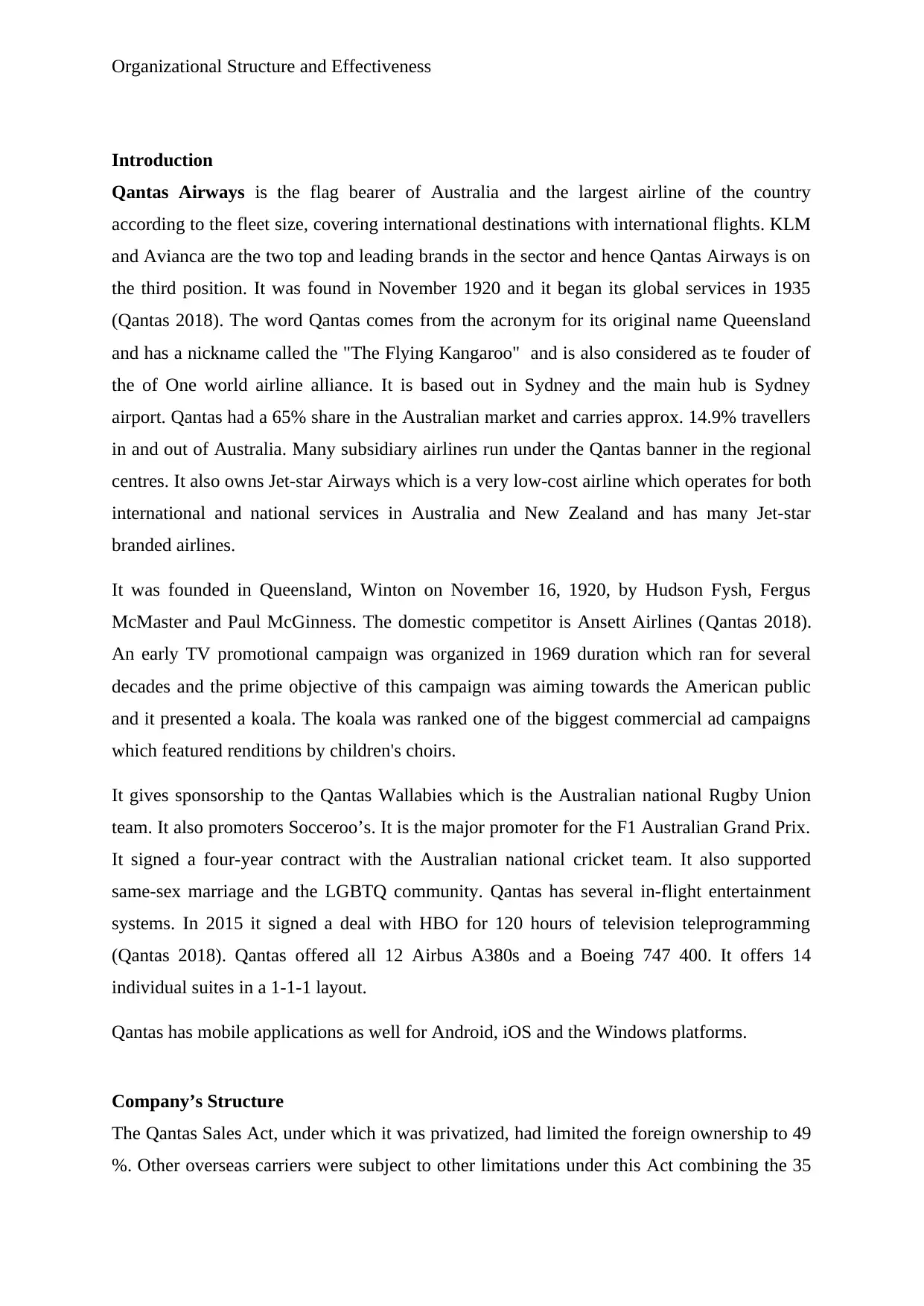
Organizational Structure and Effectiveness
Introduction
Qantas Airways is the flag bearer of Australia and the largest airline of the country
according to the fleet size, covering international destinations with international flights. KLM
and Avianca are the two top and leading brands in the sector and hence Qantas Airways is on
the third position. It was found in November 1920 and it began its global services in 1935
(Qantas 2018). The word Qantas comes from the acronym for its original name Queensland
and has a nickname called the "The Flying Kangaroo" and is also considered as te fouder of
the of One world airline alliance. It is based out in Sydney and the main hub is Sydney
airport. Qantas had a 65% share in the Australian market and carries approx. 14.9% travellers
in and out of Australia. Many subsidiary airlines run under the Qantas banner in the regional
centres. It also owns Jet-star Airways which is a very low-cost airline which operates for both
international and national services in Australia and New Zealand and has many Jet-star
branded airlines.
It was founded in Queensland, Winton on November 16, 1920, by Hudson Fysh, Fergus
McMaster and Paul McGinness. The domestic competitor is Ansett Airlines (Qantas 2018).
An early TV promotional campaign was organized in 1969 duration which ran for several
decades and the prime objective of this campaign was aiming towards the American public
and it presented a koala. The koala was ranked one of the biggest commercial ad campaigns
which featured renditions by children's choirs.
It gives sponsorship to the Qantas Wallabies which is the Australian national Rugby Union
team. It also promoters Socceroo’s. It is the major promoter for the F1 Australian Grand Prix.
It signed a four-year contract with the Australian national cricket team. It also supported
same-sex marriage and the LGBTQ community. Qantas has several in-flight entertainment
systems. In 2015 it signed a deal with HBO for 120 hours of television teleprogramming
(Qantas 2018). Qantas offered all 12 Airbus A380s and a Boeing 747 400. It offers 14
individual suites in a 1-1-1 layout.
Qantas has mobile applications as well for Android, iOS and the Windows platforms.
Company’s Structure
The Qantas Sales Act, under which it was privatized, had limited the foreign ownership to 49
%. Other overseas carriers were subject to other limitations under this Act combining the 35
Introduction
Qantas Airways is the flag bearer of Australia and the largest airline of the country
according to the fleet size, covering international destinations with international flights. KLM
and Avianca are the two top and leading brands in the sector and hence Qantas Airways is on
the third position. It was found in November 1920 and it began its global services in 1935
(Qantas 2018). The word Qantas comes from the acronym for its original name Queensland
and has a nickname called the "The Flying Kangaroo" and is also considered as te fouder of
the of One world airline alliance. It is based out in Sydney and the main hub is Sydney
airport. Qantas had a 65% share in the Australian market and carries approx. 14.9% travellers
in and out of Australia. Many subsidiary airlines run under the Qantas banner in the regional
centres. It also owns Jet-star Airways which is a very low-cost airline which operates for both
international and national services in Australia and New Zealand and has many Jet-star
branded airlines.
It was founded in Queensland, Winton on November 16, 1920, by Hudson Fysh, Fergus
McMaster and Paul McGinness. The domestic competitor is Ansett Airlines (Qantas 2018).
An early TV promotional campaign was organized in 1969 duration which ran for several
decades and the prime objective of this campaign was aiming towards the American public
and it presented a koala. The koala was ranked one of the biggest commercial ad campaigns
which featured renditions by children's choirs.
It gives sponsorship to the Qantas Wallabies which is the Australian national Rugby Union
team. It also promoters Socceroo’s. It is the major promoter for the F1 Australian Grand Prix.
It signed a four-year contract with the Australian national cricket team. It also supported
same-sex marriage and the LGBTQ community. Qantas has several in-flight entertainment
systems. In 2015 it signed a deal with HBO for 120 hours of television teleprogramming
(Qantas 2018). Qantas offered all 12 Airbus A380s and a Boeing 747 400. It offers 14
individual suites in a 1-1-1 layout.
Qantas has mobile applications as well for Android, iOS and the Windows platforms.
Company’s Structure
The Qantas Sales Act, under which it was privatized, had limited the foreign ownership to 49
%. Other overseas carriers were subject to other limitations under this Act combining the 35
⊘ This is a preview!⊘
Do you want full access?
Subscribe today to unlock all pages.

Trusted by 1+ million students worldwide
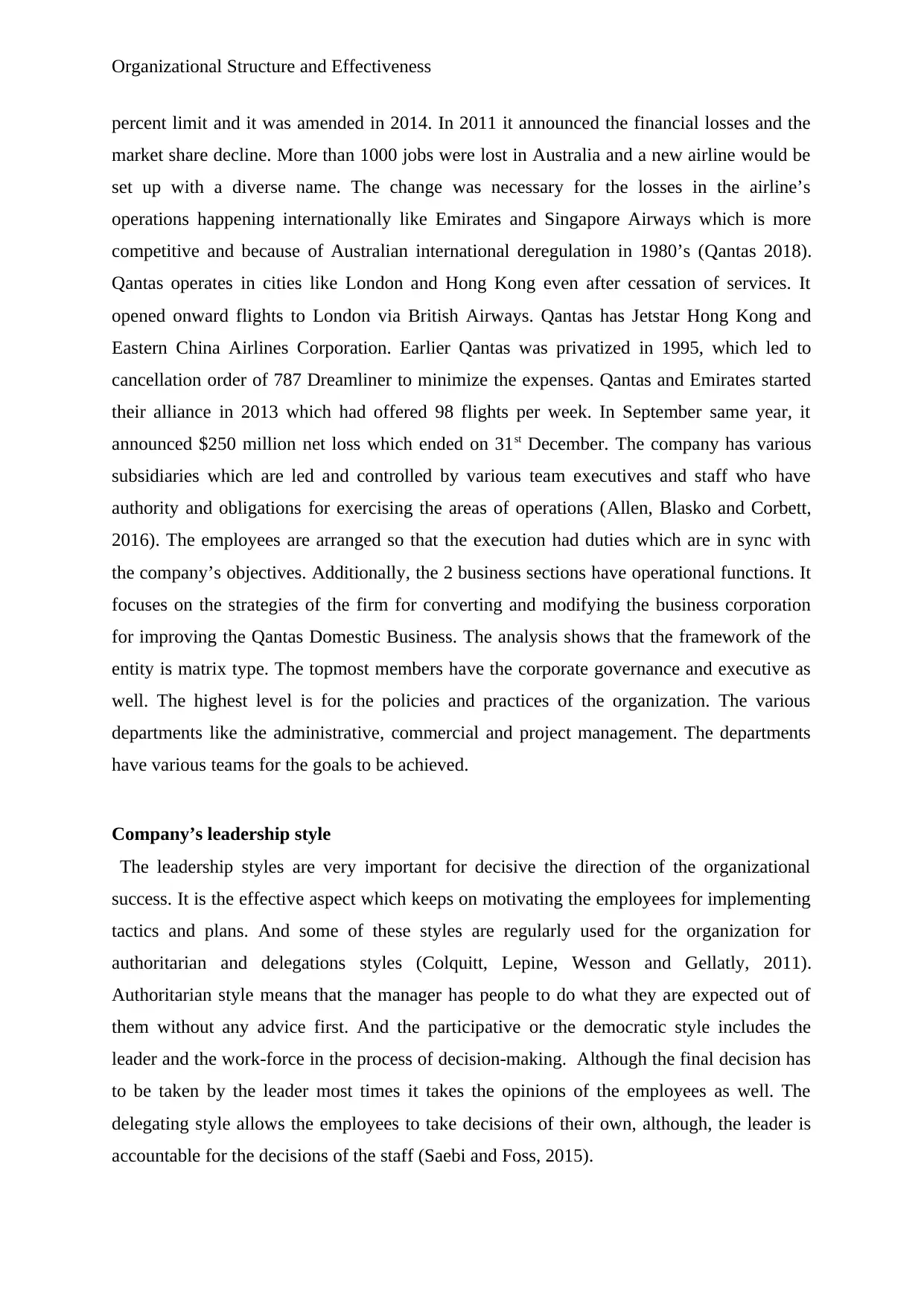
Organizational Structure and Effectiveness
percent limit and it was amended in 2014. In 2011 it announced the financial losses and the
market share decline. More than 1000 jobs were lost in Australia and a new airline would be
set up with a diverse name. The change was necessary for the losses in the airline’s
operations happening internationally like Emirates and Singapore Airways which is more
competitive and because of Australian international deregulation in 1980’s (Qantas 2018).
Qantas operates in cities like London and Hong Kong even after cessation of services. It
opened onward flights to London via British Airways. Qantas has Jetstar Hong Kong and
Eastern China Airlines Corporation. Earlier Qantas was privatized in 1995, which led to
cancellation order of 787 Dreamliner to minimize the expenses. Qantas and Emirates started
their alliance in 2013 which had offered 98 flights per week. In September same year, it
announced $250 million net loss which ended on 31st December. The company has various
subsidiaries which are led and controlled by various team executives and staff who have
authority and obligations for exercising the areas of operations (Allen, Blasko and Corbett,
2016). The employees are arranged so that the execution had duties which are in sync with
the company’s objectives. Additionally, the 2 business sections have operational functions. It
focuses on the strategies of the firm for converting and modifying the business corporation
for improving the Qantas Domestic Business. The analysis shows that the framework of the
entity is matrix type. The topmost members have the corporate governance and executive as
well. The highest level is for the policies and practices of the organization. The various
departments like the administrative, commercial and project management. The departments
have various teams for the goals to be achieved.
Company’s leadership style
The leadership styles are very important for decisive the direction of the organizational
success. It is the effective aspect which keeps on motivating the employees for implementing
tactics and plans. And some of these styles are regularly used for the organization for
authoritarian and delegations styles (Colquitt, Lepine, Wesson and Gellatly, 2011).
Authoritarian style means that the manager has people to do what they are expected out of
them without any advice first. And the participative or the democratic style includes the
leader and the work-force in the process of decision-making. Although the final decision has
to be taken by the leader most times it takes the opinions of the employees as well. The
delegating style allows the employees to take decisions of their own, although, the leader is
accountable for the decisions of the staff (Saebi and Foss, 2015).
percent limit and it was amended in 2014. In 2011 it announced the financial losses and the
market share decline. More than 1000 jobs were lost in Australia and a new airline would be
set up with a diverse name. The change was necessary for the losses in the airline’s
operations happening internationally like Emirates and Singapore Airways which is more
competitive and because of Australian international deregulation in 1980’s (Qantas 2018).
Qantas operates in cities like London and Hong Kong even after cessation of services. It
opened onward flights to London via British Airways. Qantas has Jetstar Hong Kong and
Eastern China Airlines Corporation. Earlier Qantas was privatized in 1995, which led to
cancellation order of 787 Dreamliner to minimize the expenses. Qantas and Emirates started
their alliance in 2013 which had offered 98 flights per week. In September same year, it
announced $250 million net loss which ended on 31st December. The company has various
subsidiaries which are led and controlled by various team executives and staff who have
authority and obligations for exercising the areas of operations (Allen, Blasko and Corbett,
2016). The employees are arranged so that the execution had duties which are in sync with
the company’s objectives. Additionally, the 2 business sections have operational functions. It
focuses on the strategies of the firm for converting and modifying the business corporation
for improving the Qantas Domestic Business. The analysis shows that the framework of the
entity is matrix type. The topmost members have the corporate governance and executive as
well. The highest level is for the policies and practices of the organization. The various
departments like the administrative, commercial and project management. The departments
have various teams for the goals to be achieved.
Company’s leadership style
The leadership styles are very important for decisive the direction of the organizational
success. It is the effective aspect which keeps on motivating the employees for implementing
tactics and plans. And some of these styles are regularly used for the organization for
authoritarian and delegations styles (Colquitt, Lepine, Wesson and Gellatly, 2011).
Authoritarian style means that the manager has people to do what they are expected out of
them without any advice first. And the participative or the democratic style includes the
leader and the work-force in the process of decision-making. Although the final decision has
to be taken by the leader most times it takes the opinions of the employees as well. The
delegating style allows the employees to take decisions of their own, although, the leader is
accountable for the decisions of the staff (Saebi and Foss, 2015).
Paraphrase This Document
Need a fresh take? Get an instant paraphrase of this document with our AI Paraphraser
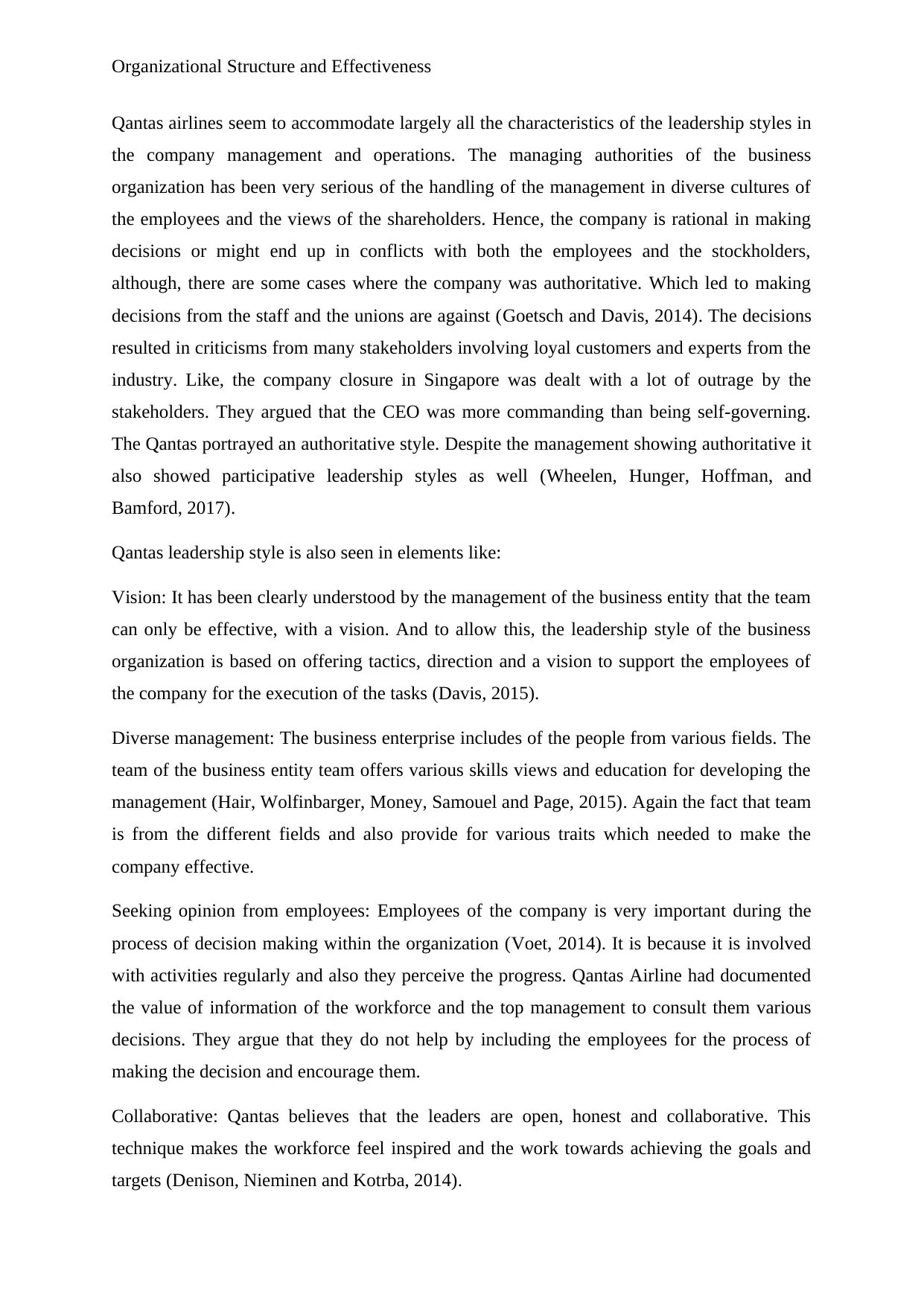
Organizational Structure and Effectiveness
Qantas airlines seem to accommodate largely all the characteristics of the leadership styles in
the company management and operations. The managing authorities of the business
organization has been very serious of the handling of the management in diverse cultures of
the employees and the views of the shareholders. Hence, the company is rational in making
decisions or might end up in conflicts with both the employees and the stockholders,
although, there are some cases where the company was authoritative. Which led to making
decisions from the staff and the unions are against (Goetsch and Davis, 2014). The decisions
resulted in criticisms from many stakeholders involving loyal customers and experts from the
industry. Like, the company closure in Singapore was dealt with a lot of outrage by the
stakeholders. They argued that the CEO was more commanding than being self-governing.
The Qantas portrayed an authoritative style. Despite the management showing authoritative it
also showed participative leadership styles as well (Wheelen, Hunger, Hoffman, and
Bamford, 2017).
Qantas leadership style is also seen in elements like:
Vision: It has been clearly understood by the management of the business entity that the team
can only be effective, with a vision. And to allow this, the leadership style of the business
organization is based on offering tactics, direction and a vision to support the employees of
the company for the execution of the tasks (Davis, 2015).
Diverse management: The business enterprise includes of the people from various fields. The
team of the business entity team offers various skills views and education for developing the
management (Hair, Wolfinbarger, Money, Samouel and Page, 2015). Again the fact that team
is from the different fields and also provide for various traits which needed to make the
company effective.
Seeking opinion from employees: Employees of the company is very important during the
process of decision making within the organization (Voet, 2014). It is because it is involved
with activities regularly and also they perceive the progress. Qantas Airline had documented
the value of information of the workforce and the top management to consult them various
decisions. They argue that they do not help by including the employees for the process of
making the decision and encourage them.
Collaborative: Qantas believes that the leaders are open, honest and collaborative. This
technique makes the workforce feel inspired and the work towards achieving the goals and
targets (Denison, Nieminen and Kotrba, 2014).
Qantas airlines seem to accommodate largely all the characteristics of the leadership styles in
the company management and operations. The managing authorities of the business
organization has been very serious of the handling of the management in diverse cultures of
the employees and the views of the shareholders. Hence, the company is rational in making
decisions or might end up in conflicts with both the employees and the stockholders,
although, there are some cases where the company was authoritative. Which led to making
decisions from the staff and the unions are against (Goetsch and Davis, 2014). The decisions
resulted in criticisms from many stakeholders involving loyal customers and experts from the
industry. Like, the company closure in Singapore was dealt with a lot of outrage by the
stakeholders. They argued that the CEO was more commanding than being self-governing.
The Qantas portrayed an authoritative style. Despite the management showing authoritative it
also showed participative leadership styles as well (Wheelen, Hunger, Hoffman, and
Bamford, 2017).
Qantas leadership style is also seen in elements like:
Vision: It has been clearly understood by the management of the business entity that the team
can only be effective, with a vision. And to allow this, the leadership style of the business
organization is based on offering tactics, direction and a vision to support the employees of
the company for the execution of the tasks (Davis, 2015).
Diverse management: The business enterprise includes of the people from various fields. The
team of the business entity team offers various skills views and education for developing the
management (Hair, Wolfinbarger, Money, Samouel and Page, 2015). Again the fact that team
is from the different fields and also provide for various traits which needed to make the
company effective.
Seeking opinion from employees: Employees of the company is very important during the
process of decision making within the organization (Voet, 2014). It is because it is involved
with activities regularly and also they perceive the progress. Qantas Airline had documented
the value of information of the workforce and the top management to consult them various
decisions. They argue that they do not help by including the employees for the process of
making the decision and encourage them.
Collaborative: Qantas believes that the leaders are open, honest and collaborative. This
technique makes the workforce feel inspired and the work towards achieving the goals and
targets (Denison, Nieminen and Kotrba, 2014).
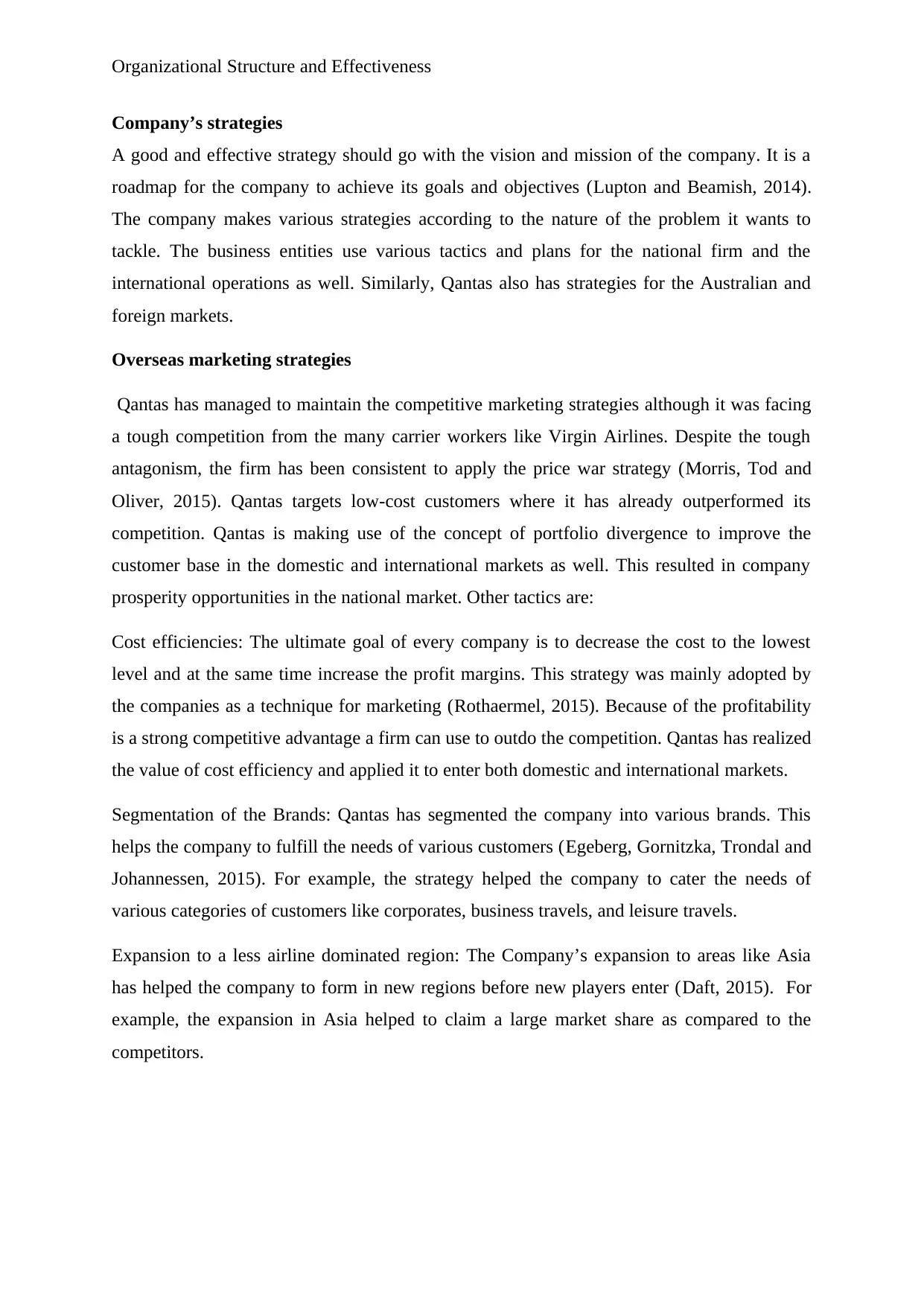
Organizational Structure and Effectiveness
Company’s strategies
A good and effective strategy should go with the vision and mission of the company. It is a
roadmap for the company to achieve its goals and objectives (Lupton and Beamish, 2014).
The company makes various strategies according to the nature of the problem it wants to
tackle. The business entities use various tactics and plans for the national firm and the
international operations as well. Similarly, Qantas also has strategies for the Australian and
foreign markets.
Overseas marketing strategies
Qantas has managed to maintain the competitive marketing strategies although it was facing
a tough competition from the many carrier workers like Virgin Airlines. Despite the tough
antagonism, the firm has been consistent to apply the price war strategy (Morris, Tod and
Oliver, 2015). Qantas targets low-cost customers where it has already outperformed its
competition. Qantas is making use of the concept of portfolio divergence to improve the
customer base in the domestic and international markets as well. This resulted in company
prosperity opportunities in the national market. Other tactics are:
Cost efficiencies: The ultimate goal of every company is to decrease the cost to the lowest
level and at the same time increase the profit margins. This strategy was mainly adopted by
the companies as a technique for marketing (Rothaermel, 2015). Because of the profitability
is a strong competitive advantage a firm can use to outdo the competition. Qantas has realized
the value of cost efficiency and applied it to enter both domestic and international markets.
Segmentation of the Brands: Qantas has segmented the company into various brands. This
helps the company to fulfill the needs of various customers (Egeberg, Gornitzka, Trondal and
Johannessen, 2015). For example, the strategy helped the company to cater the needs of
various categories of customers like corporates, business travels, and leisure travels.
Expansion to a less airline dominated region: The Company’s expansion to areas like Asia
has helped the company to form in new regions before new players enter (Daft, 2015). For
example, the expansion in Asia helped to claim a large market share as compared to the
competitors.
Company’s strategies
A good and effective strategy should go with the vision and mission of the company. It is a
roadmap for the company to achieve its goals and objectives (Lupton and Beamish, 2014).
The company makes various strategies according to the nature of the problem it wants to
tackle. The business entities use various tactics and plans for the national firm and the
international operations as well. Similarly, Qantas also has strategies for the Australian and
foreign markets.
Overseas marketing strategies
Qantas has managed to maintain the competitive marketing strategies although it was facing
a tough competition from the many carrier workers like Virgin Airlines. Despite the tough
antagonism, the firm has been consistent to apply the price war strategy (Morris, Tod and
Oliver, 2015). Qantas targets low-cost customers where it has already outperformed its
competition. Qantas is making use of the concept of portfolio divergence to improve the
customer base in the domestic and international markets as well. This resulted in company
prosperity opportunities in the national market. Other tactics are:
Cost efficiencies: The ultimate goal of every company is to decrease the cost to the lowest
level and at the same time increase the profit margins. This strategy was mainly adopted by
the companies as a technique for marketing (Rothaermel, 2015). Because of the profitability
is a strong competitive advantage a firm can use to outdo the competition. Qantas has realized
the value of cost efficiency and applied it to enter both domestic and international markets.
Segmentation of the Brands: Qantas has segmented the company into various brands. This
helps the company to fulfill the needs of various customers (Egeberg, Gornitzka, Trondal and
Johannessen, 2015). For example, the strategy helped the company to cater the needs of
various categories of customers like corporates, business travels, and leisure travels.
Expansion to a less airline dominated region: The Company’s expansion to areas like Asia
has helped the company to form in new regions before new players enter (Daft, 2015). For
example, the expansion in Asia helped to claim a large market share as compared to the
competitors.
⊘ This is a preview!⊘
Do you want full access?
Subscribe today to unlock all pages.

Trusted by 1+ million students worldwide
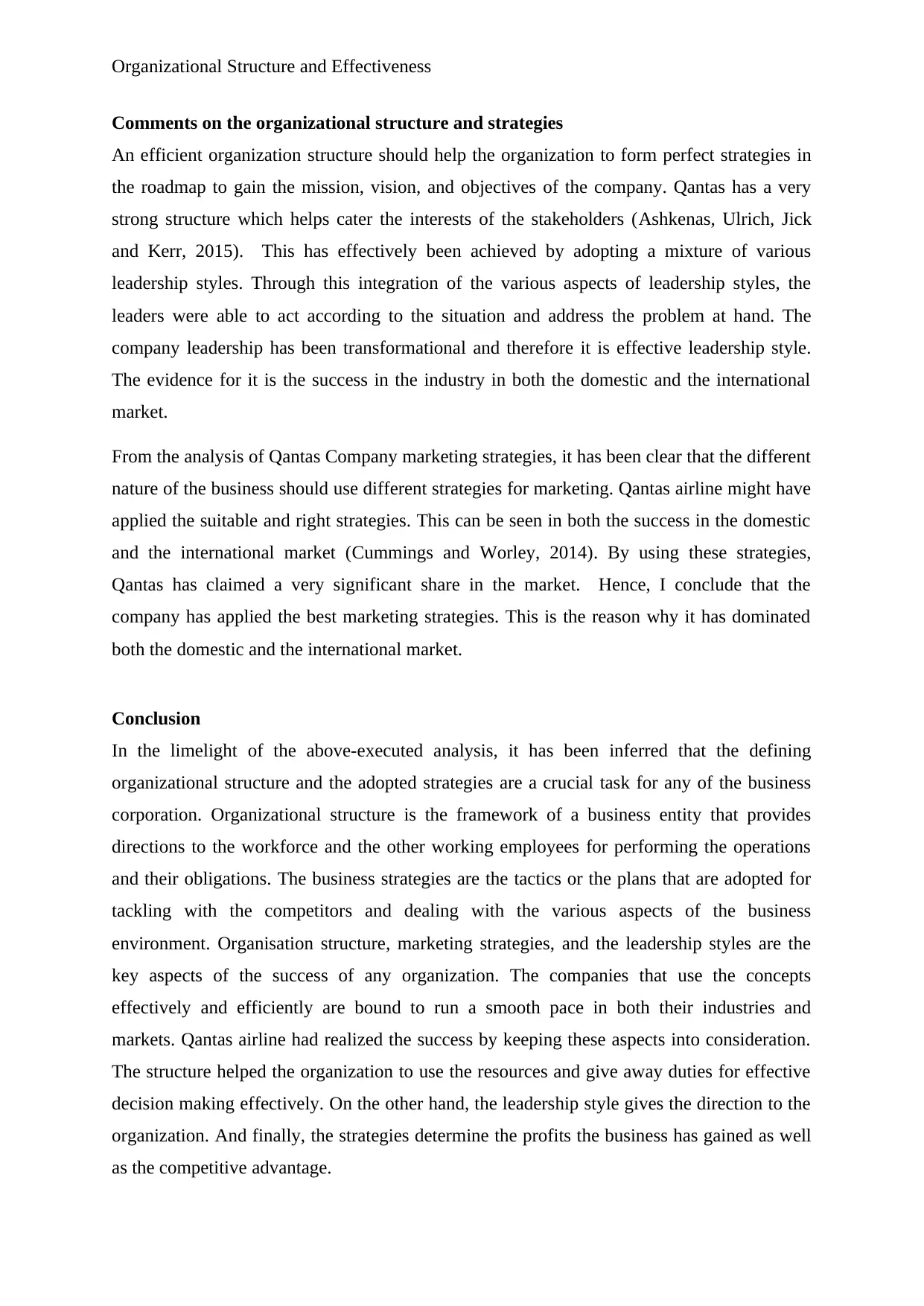
Organizational Structure and Effectiveness
Comments on the organizational structure and strategies
An efficient organization structure should help the organization to form perfect strategies in
the roadmap to gain the mission, vision, and objectives of the company. Qantas has a very
strong structure which helps cater the interests of the stakeholders (Ashkenas, Ulrich, Jick
and Kerr, 2015). This has effectively been achieved by adopting a mixture of various
leadership styles. Through this integration of the various aspects of leadership styles, the
leaders were able to act according to the situation and address the problem at hand. The
company leadership has been transformational and therefore it is effective leadership style.
The evidence for it is the success in the industry in both the domestic and the international
market.
From the analysis of Qantas Company marketing strategies, it has been clear that the different
nature of the business should use different strategies for marketing. Qantas airline might have
applied the suitable and right strategies. This can be seen in both the success in the domestic
and the international market (Cummings and Worley, 2014). By using these strategies,
Qantas has claimed a very significant share in the market. Hence, I conclude that the
company has applied the best marketing strategies. This is the reason why it has dominated
both the domestic and the international market.
Conclusion
In the limelight of the above-executed analysis, it has been inferred that the defining
organizational structure and the adopted strategies are a crucial task for any of the business
corporation. Organizational structure is the framework of a business entity that provides
directions to the workforce and the other working employees for performing the operations
and their obligations. The business strategies are the tactics or the plans that are adopted for
tackling with the competitors and dealing with the various aspects of the business
environment. Organisation structure, marketing strategies, and the leadership styles are the
key aspects of the success of any organization. The companies that use the concepts
effectively and efficiently are bound to run a smooth pace in both their industries and
markets. Qantas airline had realized the success by keeping these aspects into consideration.
The structure helped the organization to use the resources and give away duties for effective
decision making effectively. On the other hand, the leadership style gives the direction to the
organization. And finally, the strategies determine the profits the business has gained as well
as the competitive advantage.
Comments on the organizational structure and strategies
An efficient organization structure should help the organization to form perfect strategies in
the roadmap to gain the mission, vision, and objectives of the company. Qantas has a very
strong structure which helps cater the interests of the stakeholders (Ashkenas, Ulrich, Jick
and Kerr, 2015). This has effectively been achieved by adopting a mixture of various
leadership styles. Through this integration of the various aspects of leadership styles, the
leaders were able to act according to the situation and address the problem at hand. The
company leadership has been transformational and therefore it is effective leadership style.
The evidence for it is the success in the industry in both the domestic and the international
market.
From the analysis of Qantas Company marketing strategies, it has been clear that the different
nature of the business should use different strategies for marketing. Qantas airline might have
applied the suitable and right strategies. This can be seen in both the success in the domestic
and the international market (Cummings and Worley, 2014). By using these strategies,
Qantas has claimed a very significant share in the market. Hence, I conclude that the
company has applied the best marketing strategies. This is the reason why it has dominated
both the domestic and the international market.
Conclusion
In the limelight of the above-executed analysis, it has been inferred that the defining
organizational structure and the adopted strategies are a crucial task for any of the business
corporation. Organizational structure is the framework of a business entity that provides
directions to the workforce and the other working employees for performing the operations
and their obligations. The business strategies are the tactics or the plans that are adopted for
tackling with the competitors and dealing with the various aspects of the business
environment. Organisation structure, marketing strategies, and the leadership styles are the
key aspects of the success of any organization. The companies that use the concepts
effectively and efficiently are bound to run a smooth pace in both their industries and
markets. Qantas airline had realized the success by keeping these aspects into consideration.
The structure helped the organization to use the resources and give away duties for effective
decision making effectively. On the other hand, the leadership style gives the direction to the
organization. And finally, the strategies determine the profits the business has gained as well
as the competitive advantage.
Paraphrase This Document
Need a fresh take? Get an instant paraphrase of this document with our AI Paraphraser
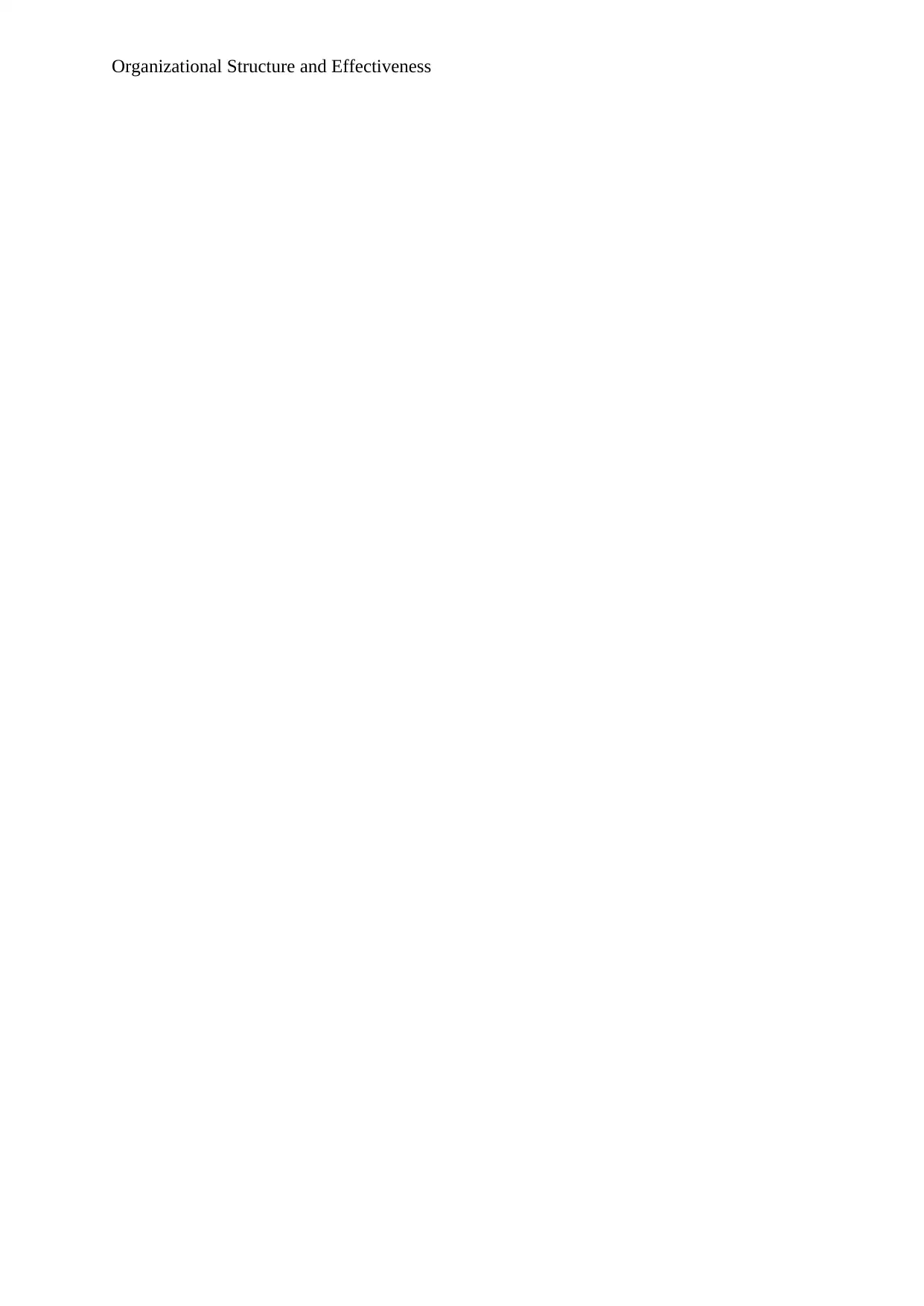
Organizational Structure and Effectiveness
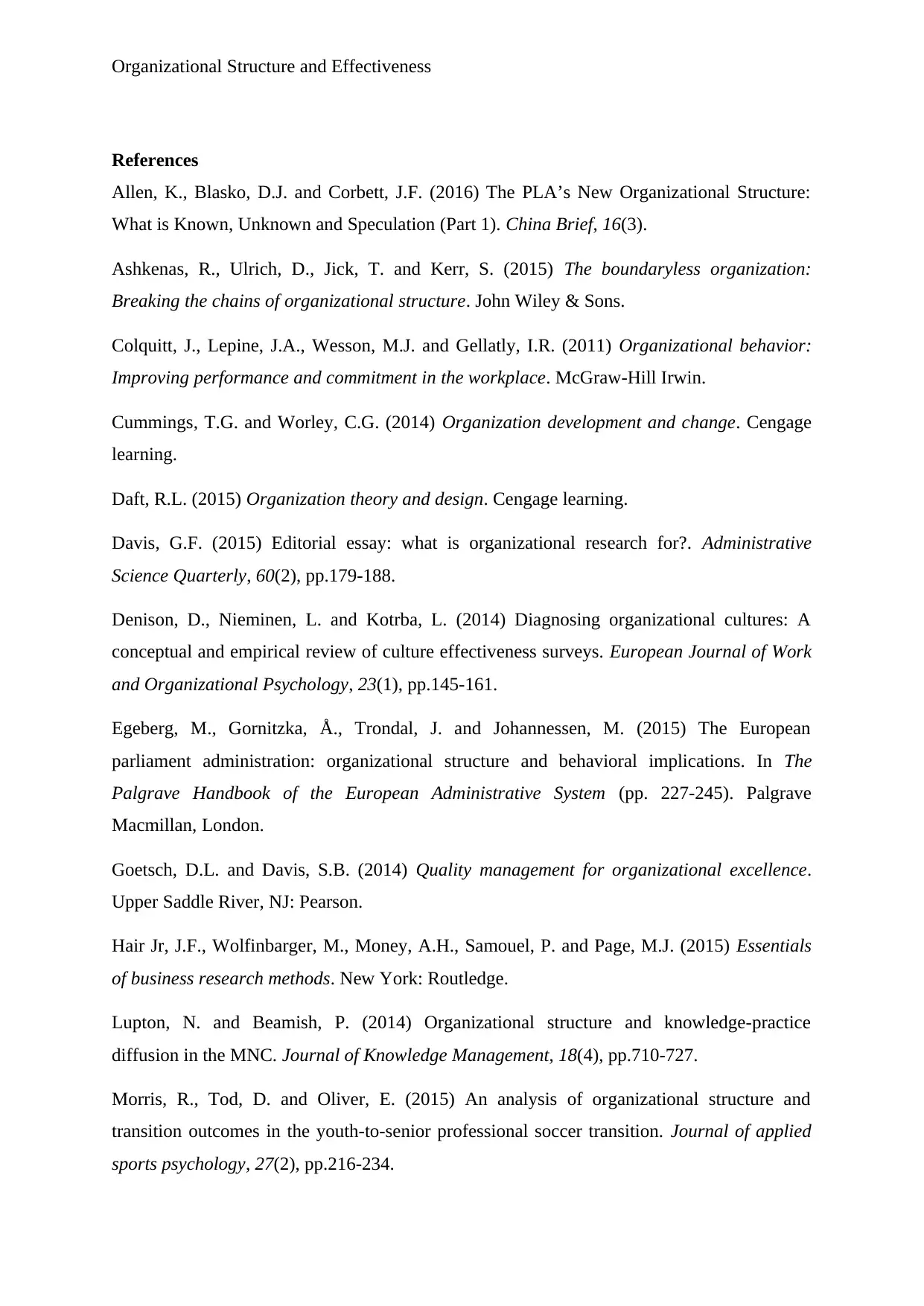
Organizational Structure and Effectiveness
References
Allen, K., Blasko, D.J. and Corbett, J.F. (2016) The PLA’s New Organizational Structure:
What is Known, Unknown and Speculation (Part 1). China Brief, 16(3).
Ashkenas, R., Ulrich, D., Jick, T. and Kerr, S. (2015) The boundaryless organization:
Breaking the chains of organizational structure. John Wiley & Sons.
Colquitt, J., Lepine, J.A., Wesson, M.J. and Gellatly, I.R. (2011) Organizational behavior:
Improving performance and commitment in the workplace. McGraw-Hill Irwin.
Cummings, T.G. and Worley, C.G. (2014) Organization development and change. Cengage
learning.
Daft, R.L. (2015) Organization theory and design. Cengage learning.
Davis, G.F. (2015) Editorial essay: what is organizational research for?. Administrative
Science Quarterly, 60(2), pp.179-188.
Denison, D., Nieminen, L. and Kotrba, L. (2014) Diagnosing organizational cultures: A
conceptual and empirical review of culture effectiveness surveys. European Journal of Work
and Organizational Psychology, 23(1), pp.145-161.
Egeberg, M., Gornitzka, Å., Trondal, J. and Johannessen, M. (2015) The European
parliament administration: organizational structure and behavioral implications. In The
Palgrave Handbook of the European Administrative System (pp. 227-245). Palgrave
Macmillan, London.
Goetsch, D.L. and Davis, S.B. (2014) Quality management for organizational excellence.
Upper Saddle River, NJ: Pearson.
Hair Jr, J.F., Wolfinbarger, M., Money, A.H., Samouel, P. and Page, M.J. (2015) Essentials
of business research methods. New York: Routledge.
Lupton, N. and Beamish, P. (2014) Organizational structure and knowledge-practice
diffusion in the MNC. Journal of Knowledge Management, 18(4), pp.710-727.
Morris, R., Tod, D. and Oliver, E. (2015) An analysis of organizational structure and
transition outcomes in the youth-to-senior professional soccer transition. Journal of applied
sports psychology, 27(2), pp.216-234.
References
Allen, K., Blasko, D.J. and Corbett, J.F. (2016) The PLA’s New Organizational Structure:
What is Known, Unknown and Speculation (Part 1). China Brief, 16(3).
Ashkenas, R., Ulrich, D., Jick, T. and Kerr, S. (2015) The boundaryless organization:
Breaking the chains of organizational structure. John Wiley & Sons.
Colquitt, J., Lepine, J.A., Wesson, M.J. and Gellatly, I.R. (2011) Organizational behavior:
Improving performance and commitment in the workplace. McGraw-Hill Irwin.
Cummings, T.G. and Worley, C.G. (2014) Organization development and change. Cengage
learning.
Daft, R.L. (2015) Organization theory and design. Cengage learning.
Davis, G.F. (2015) Editorial essay: what is organizational research for?. Administrative
Science Quarterly, 60(2), pp.179-188.
Denison, D., Nieminen, L. and Kotrba, L. (2014) Diagnosing organizational cultures: A
conceptual and empirical review of culture effectiveness surveys. European Journal of Work
and Organizational Psychology, 23(1), pp.145-161.
Egeberg, M., Gornitzka, Å., Trondal, J. and Johannessen, M. (2015) The European
parliament administration: organizational structure and behavioral implications. In The
Palgrave Handbook of the European Administrative System (pp. 227-245). Palgrave
Macmillan, London.
Goetsch, D.L. and Davis, S.B. (2014) Quality management for organizational excellence.
Upper Saddle River, NJ: Pearson.
Hair Jr, J.F., Wolfinbarger, M., Money, A.H., Samouel, P. and Page, M.J. (2015) Essentials
of business research methods. New York: Routledge.
Lupton, N. and Beamish, P. (2014) Organizational structure and knowledge-practice
diffusion in the MNC. Journal of Knowledge Management, 18(4), pp.710-727.
Morris, R., Tod, D. and Oliver, E. (2015) An analysis of organizational structure and
transition outcomes in the youth-to-senior professional soccer transition. Journal of applied
sports psychology, 27(2), pp.216-234.
⊘ This is a preview!⊘
Do you want full access?
Subscribe today to unlock all pages.

Trusted by 1+ million students worldwide
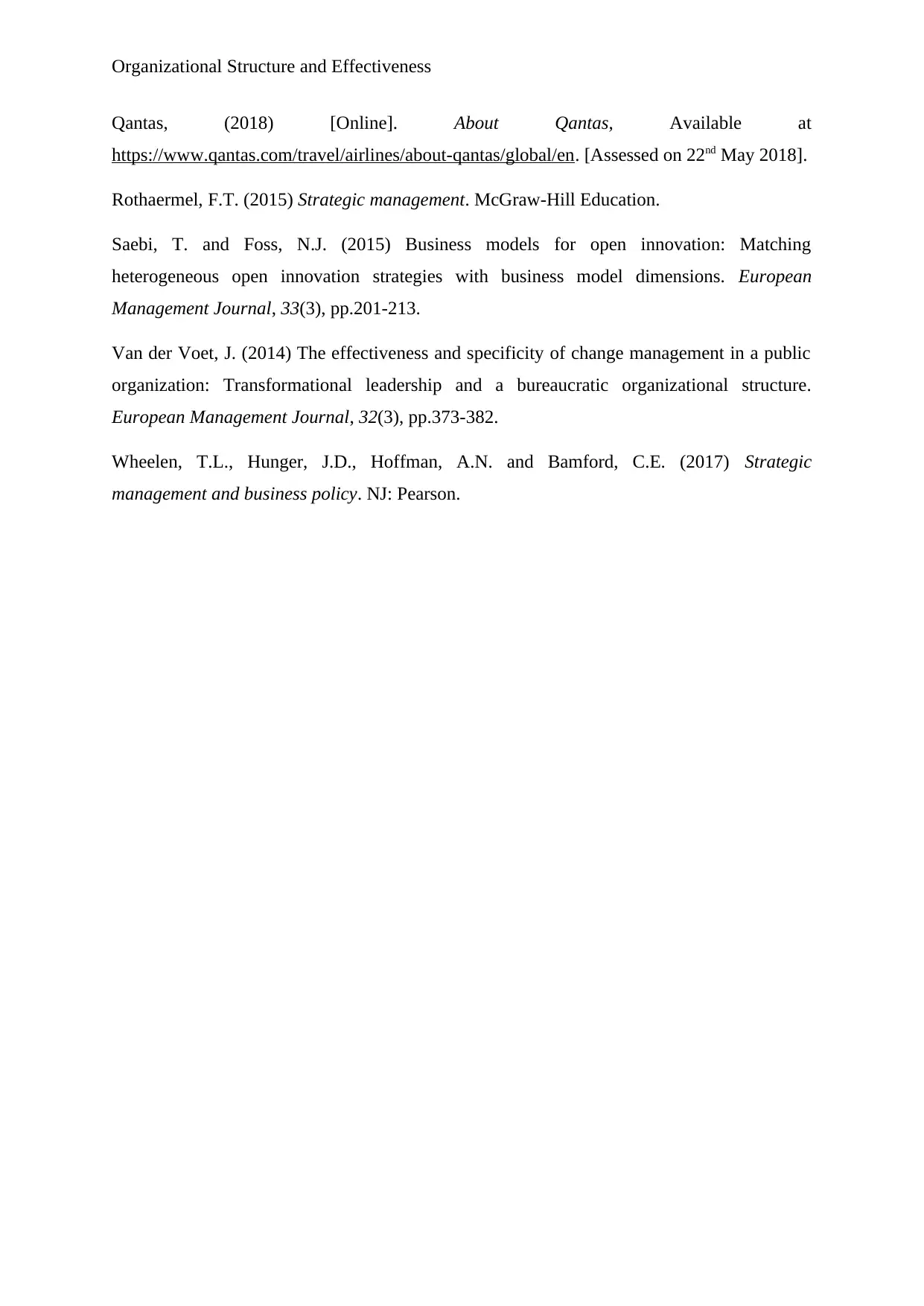
Organizational Structure and Effectiveness
Qantas, (2018) [Online]. About Qantas, Available at
https://www.qantas.com/travel/airlines/about-qantas/global/en. [Assessed on 22nd May 2018].
Rothaermel, F.T. (2015) Strategic management. McGraw-Hill Education.
Saebi, T. and Foss, N.J. (2015) Business models for open innovation: Matching
heterogeneous open innovation strategies with business model dimensions. European
Management Journal, 33(3), pp.201-213.
Van der Voet, J. (2014) The effectiveness and specificity of change management in a public
organization: Transformational leadership and a bureaucratic organizational structure.
European Management Journal, 32(3), pp.373-382.
Wheelen, T.L., Hunger, J.D., Hoffman, A.N. and Bamford, C.E. (2017) Strategic
management and business policy. NJ: Pearson.
Qantas, (2018) [Online]. About Qantas, Available at
https://www.qantas.com/travel/airlines/about-qantas/global/en. [Assessed on 22nd May 2018].
Rothaermel, F.T. (2015) Strategic management. McGraw-Hill Education.
Saebi, T. and Foss, N.J. (2015) Business models for open innovation: Matching
heterogeneous open innovation strategies with business model dimensions. European
Management Journal, 33(3), pp.201-213.
Van der Voet, J. (2014) The effectiveness and specificity of change management in a public
organization: Transformational leadership and a bureaucratic organizational structure.
European Management Journal, 32(3), pp.373-382.
Wheelen, T.L., Hunger, J.D., Hoffman, A.N. and Bamford, C.E. (2017) Strategic
management and business policy. NJ: Pearson.
1 out of 10
Related Documents
Your All-in-One AI-Powered Toolkit for Academic Success.
+13062052269
info@desklib.com
Available 24*7 on WhatsApp / Email
![[object Object]](/_next/static/media/star-bottom.7253800d.svg)
Unlock your academic potential
Copyright © 2020–2025 A2Z Services. All Rights Reserved. Developed and managed by ZUCOL.




